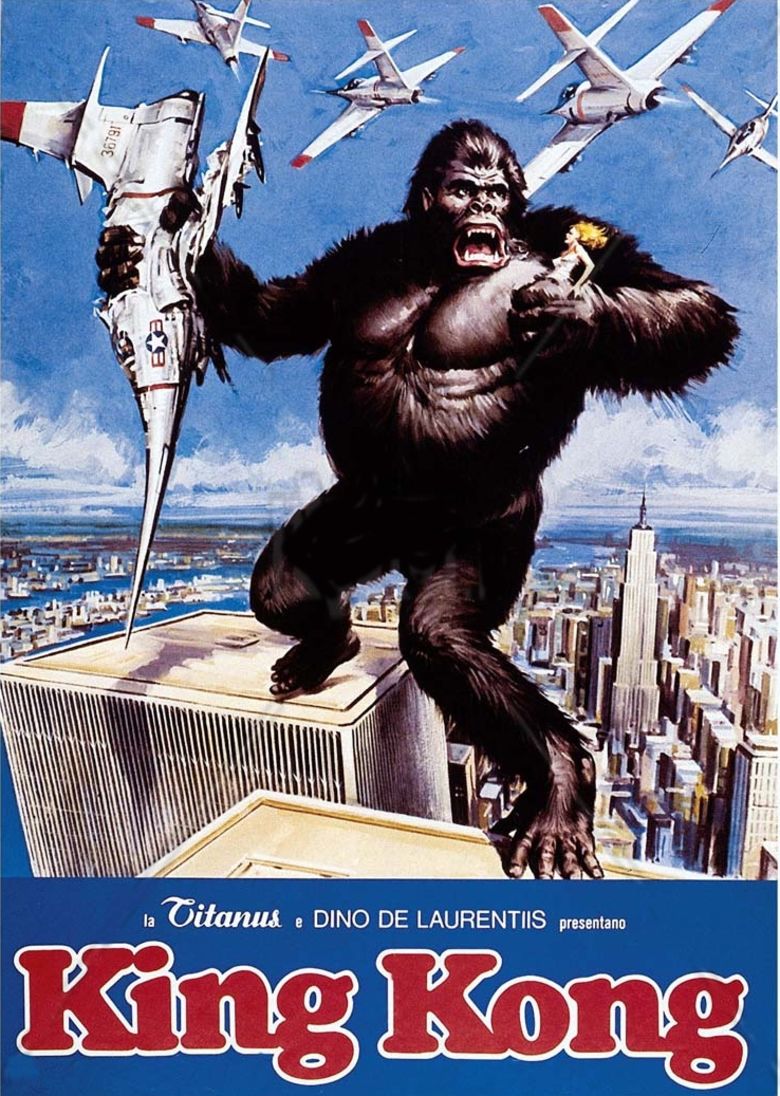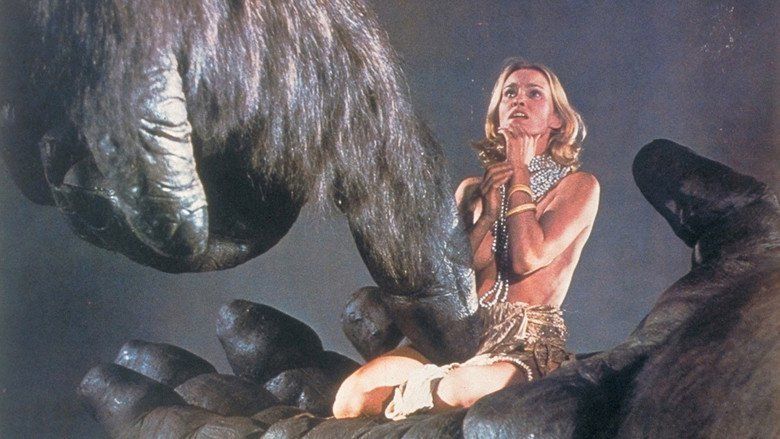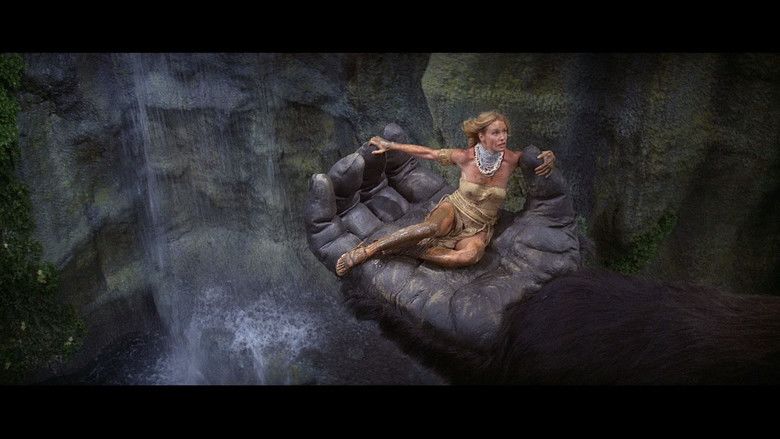King Kong (1976 film)
5.8 /10 1 Votes
46% Rotten Tomatoes Country United States | 5.8/10 IMDb 3.5/5 Den of Geek Genre Adventure, Fantasy, Horror Duration Language English | |||||||||||||||||||||||||||||||||
 | ||||||||||||||||||||||||||||||||||
Release date December 17, 1976 (1976-12-17) Based on 1933 screenplay byJames Ashmore CreelmanRuth Rosefrom idea byMerian C. CooperEdgar Wallace Writer James Ashmore Creelman, Ruth Rose, Merian C. Cooper (from an idea conceived by), Edgar Wallace (from an idea conceived by), Lorenzo Semple Jr. (screenplay) Genres Horror, Monster movie, Adventure Film, Action/Adventure Cast (Jack Prescott), (Dwan), (Fred Wilson), (Captain Ross), Rene Auberjonois (Roy Bagley), (Boan)Similar movies Jurassic World , Self/less , Dawn of the Planet of the Apes , Mission: Impossible II , The Incredibles , Jurassic Park Tagline The most exciting original motion picture event of all time. | ||||||||||||||||||||||||||||||||||
King kong 1976 jessica lange
King Kong is a 1976 American monster film produced by Dino De Laurentiis and directed by John Guillermin. It is a modern remake of the 1933 classic film of the same name about a giant ape that is captured and imported to New York City for exhibition. Featuring special effects by Carlo Rambaldi, it stars Jeff Bridges, Charles Grodin, and Jessica Lange in her first film role.
Contents
- King kong 1976 jessica lange
- Plot
- Cast
- Screenplay
- Casting
- Filming
- Music
- Extended television version
- Home media
- Reception
- Awards
- References

The remake's screenplay was written by Lorenzo Semple Jr., based on the 1933 screenplay by James Ashmore Creelman and Ruth Rose, and from the original idea by Merian C. Cooper and Edgar Wallace.

The film was the fifth highest grossing film of 1977 according to box office statistics compiled during its release by Variety, and Box Office Mojo published a list indicating it was the 7th highest grossing film of 1976 in North America. It won the Academy Award for Best Visual Effects and was also nominated for Best Cinematography and Best Sound.

It is the only King Kong film to feature the World Trade Center instead of the Empire State Building.

A sequel titled King Kong Lives was released in 1986.
Plot
Fred Wilson, an executive of the Petrox Oil Company, forms an expedition based on infrared imagery which reveals a previously undiscovered Indian Ocean island hidden by a permanent cloud bank. Wilson believes that the island holds vast untapped deposits of oil, a potential fortune which he is determined to secure for Petrox. Unknown to Wilson or the crew, Jack Prescott, a primate paleontologist who wants to see the island for himself, has stowed away on the expedition's vessel, the Petrox Explorer. Prescott reveals himself when he warns the crew that the cloud bank may be caused by some unknown, and potentially dangerous, phenomenon. Wilson orders Prescott locked up, believing him to be a corporate spy from a rival oil company. While being escorted to lock-up, Prescott spots a life raft which, upon inspection, is found to be carrying the beautiful and unconscious Dwan. After conducting a thorough background check on the 'spy', Wilson realizes that he is telling the truth and appoints Prescott as the expedition's official photographer, requesting that, due to his medical training, he be present when Dwan revives. When she does regain consciousness, Dwan states that she is an aspiring actress who was aboard a director's yacht, which suddenly and inexplicably exploded.
When the Petrox Explorer arrives at the island, the team discovers a primitive tribe of natives who live within the confines of a gigantic wall. The tribal chief shows an immediate interest in the blonde Dwan, offering to trade several of the native women for her, an offer firmly rejected by Jack. The team then learn that while the island does indeed contain large deposits of oil, it is of such low quality that it is unusable. Later that night, the natives secretly board the ship and kidnap Dwan, drugging her and offering her as a sacrifice to a giant ape known as Kong. Kong frees Dwan from the stronghold and retreats into the depths of the island.
Although an awesome and terrifying sight, the soft-hearted Kong quickly becomes infatuated by Dwan, whose rambling monologue both calms and fascinates the monstrous beast, taming his baser, more violent instincts. After Dwan falls into mud, Kong takes her back to a waterfall to wash her and dry her with great gusts of his warm breath.
In the meantime, Jack and First Mate Carnahan lead several crew members on a rescue mission to save Dwan. The search party encounters Kong while crossing a log bridge. Enraged by the intrusion into his territory, Kong rolls the huge log, sending Carnahan and all but one of the team plummeting to their deaths. Jack and Boan are the only ones to survive. While Boan returns to the village, Jack presses on looking for Dwan. Kong takes Dwan to his lair. As he starts to undress her, a giant snake appears and attacks them. While the distracted Kong is fighting the snake, Jack arrives and rescues Dwan. After killing the snake, Kong chases them back to the native village. Smashing down the huge gates, he falls into a pit trap that Wilson and the crew have dug, where he is overcome by chloroform.
After learning that the oil cannot be refined, Wilson has instead decided to salvage the expedition by transporting the captive Kong to America as a promotional gimmick for Petrox. When they reach New York City, Kong is put on display, bound in chains with a large crown on his head. When Kong sees a group of reporters pushing and shoving Dwan for interviews, the ape, believing that Dwan is being harmed, breaks free of his bonds. A stampede ensues as panic engulfs the throng, with people crushed and trampled as Kong strides through the crowd. Wilson, trying to flee, loses his footing and is flattened by Kong.
Jack and Dwan flee across the Queensboro Bridge to Manhattan and take refuge in an abandoned bar, where Jack notices a similarity between the Manhattan skyline (notably the World Trade Center Twin Towers) and the mountainous terrain of Kong's island. He runs downstairs to call the mayor's office and tells them to let Kong climb to the top of the World Trade Center. Before Jack can return, Kong discovers Dwan and snatches her from the bar, then makes his way to the World Trade Center with Jack and the National Guard in pursuit.
Kong climbs to the roof of the South Tower of the World Trade Center, where he is attacked by soldiers armed with flamethrowers. Kong manages to evade them with a spectacular leap across to the roof of the North Tower. He rips pieces of equipment from the roof and throws them at the soldiers, killing them when he throws a tank of flammable material. Ignoring Jack's earlier request for safe, live capture, military helicopters are sent in to kill Kong (Most likely since Petrox is facing major indictment). After ensuring Dwan's safety, Kong fights the attacking helicopters, downing two of them. Dwan desperately pleads for the military to break off their assault, but the pilots continue attacking. The relentless hail of bullets finally brings Kong down; he rolls over the edge of the roof, crashing to the plaza hundreds of feet below. Dwan rushes down to comfort him and tearfully watches him take his last breath. An enormous crowd gathers around the giant ape's body as Dwan is surrounded by photographers. Jack fights his way through the crowd to get to Dwan, but stops short as she is taken away by journalists, despite her cries to him.
Cast
Screenplay
The script was written by Lorenzo Semple Jr.who later recalled:
We made a very deliberate attempt not to be anything like the original movie in tone or mood. Dino wanted it to be light and amusing, rather than portentous. I don't think the original was meant to be mythic.... The original King Kong is extremely crude. I don't mean it's not wonderful. It was remarkable for its time, but it was a very small back-lot picture. We thought times had changed so much that audiences were more sophisticated. Dino felt we could have more fun with it. We hoped to do sensational things with advanced special effects on a big screen.
Semple says Universal wanted to make their own version of the story, The Legend of King Kong, from a script by Bo Goldman, to be directed by Joseph Sargent and star Peter Falk as Carl Denham.
Casting
Meryl Streep has said that she was considered for the role of Dwan, but was deemed too unattractive by producer Dino De Laurentiis. Dwan was also proposed to Barbra Streisand but she turned it down. The role eventually went to Jessica Lange.
Filming
Producer Dino De Laurentiis first approached Roman Polanski to direct the picture.
According to King Kong: The History of a Movie Icon, director John Guillermin, known to have had outbursts from time to time on the set, got into a public shouting match with executive producer Federico De Laurentiis (son of producer Dino De Laurentiis). After the incident, Dino De Laurentiis was reported to have threatened to fire Guillermin if he did not start treating the cast and crew better. Rick Baker, who designed and wore the ape suit in collaboration with Carlo Rambaldi, was extremely disappointed in the final suit, which he felt wasn't at all convincing. He gives all the credit for its passable appearance to cinematographer Richard H. Kline. The only time that the collaboration of Rick Baker and Carlo Rambaldi went smoothly was during the design of the mechanical Kong mask. Baker's design and Rambaldi's cable work combined to give Kong's face a wide range of expression that was responsible for much of the film's emotional impact. Baker gave much of the credit for its effectiveness to Rambaldi and his mechanics. To film the scene where the Petrox Explorer finds Dwan in the life raft, Jessica Lange spent hours in a rubber raft in the freezing cold, drenched and wearing only a slinky black dress. Although Lange wasn't aware of it, there were sharks circling the raft the entire time. Shooting of this scene took place in the channel between Los Angeles and Catalina Island during the last week in January 1976.
On one of the nights of filming Kong's death at the World Trade Center, over 30,000 people showed up at the site to be extras for the scene. Although the crowd was well behaved, the Port Authority of New York & New Jersey (owner of the World Trade Center complex) became concerned that the weight of so many people would cause the plaza to collapse, and ordered the producers to shut down the filming. However, the film makers had already got the shot they wanted of the large crowd rushing toward Kong's body. They returned to the site days later to finish filming the scene, with a much smaller crowd of paid extras.
According to the Internet Movie Database, seven different masks were created by Carlo Rambaldi, and molded by Rick Baker to convey various emotions. Separate masks were necessary as there were too many cables and mechanics required for all the expressions to fit in one single mask. The masks were composed of a plastic skull over which were placed artificial muscle groups activated by cables which entered the costume through Kong's feet, with the outer latex skins molded by Baker placed over the top. The masks used hydraulics to provide movement, so much like the mechanical Kong and hands, the facial expressions were controlled by the team of operators working off-set with the control boards. To complete the look of a gorilla, Baker wore contact lenses so his eyes would resemble those of a gorilla.
Carlo Rambaldi's mechanical Kong was 40 ft (12.2 m) tall and weighed 6½ tons. It cost £500,000 to create. Despite months of preparation, the final device proved to be impossible to operate convincingly, and is only seen in a series of brief shots totaling less than 15 seconds.
Music
The film's score was composed and conducted by John Barry. A soundtrack album of highlights from the score was released in 1976 by Reprise Records on LP. This album was released on CD, first as a bootleg by the Italian label Mask in 1998, and then as a legitimate, licensed release by Film Score Monthly in 2005. On October 2, 2012, Film Score Monthly released the complete score on a two disc set; the first disc features the remastered complete score, while the second disc contains the remastered original album, along with alternate takes of various cues.
Extended television version
When King Kong made its network TV debut on NBC in 1978, a number of scenes deleted from the theatrical version were reinstated to make the film longer. This version also features several changes to the John Barry score, including entirely alternate cues in places that no music existed in the theatrical version, as well as several different edits of cues. This may actually indicate that the version was an early workprint of the film, before it went through its final editing stages. While this is the first of the Kong films to have an extended cut, the second one is the 2005 remake of King Kong. To date, the only DVD appearance of this extra footage is in the form of five deleted/extended scenes on the Region 2 release.
Home media
Momentum Pictures released this film on DVD in 2001 on the Region 2 label with a photo gallery and a theatrical trailer. This has now been deleted according to the online retailer site Zavvi. Optimum Releasing has confirmed a new re-release of this film on Region 2 with deleted scenes and the theatrical trailer from the previous issue. There are only two deleted scenes on the DVD. This is the extended scene of the brawl between Kong and the Snake. The other scene is the demise of Wilson at the New York unveiling of Kong. The film has been released on Blu-ray in Region B territories, although this disc is region-free and can work in any Blu-ray machine.
Reception
King Kong was commercially successful, earning Paramount Pictures back over triple its budget. The film ended up at #5 on Variety's chart of the top domestic (U.S.) moneymakers of 1977. (The film was released in December 1976 and therefore earned the majority of its money during the early part of 1977.) The film made just over $90 million worldwide on a $24 million budget.
After months of much anticipation for the film's release, the film received mostly mixed responses from critics at the time of its initial release, especially from fans of the original King Kong. It did however, obtain positive reviews from several prominent critics. Pauline Kael in The New Yorker, Richard Schickel in Time, Charles Champlin in the Los Angeles Times, Roger Ebert in the Chicago Sun-Times, and 'Murf' in Variety, among others, responded favorably to the film's pathos and (often campy) sense of humor. Kael, in particular, truly loved the film, noting "I don't think I've ever before seen a movie that was a comic-strip great romance in the way this one is — it's a joke that can make you cry." The performances by Bridges and Grodin were generally well regarded, and even the film's detractors found Richard H. Kline's Academy Award-nominated cinematography and John Barry's musical score noteworthy.
Critical response to King Kong continues to be mixed. Of the 36 reviewers on Rotten Tomatoes regarding the title, 50% reflect positive reactions. The critical consensus states that the film "represents a significant visual upgrade over the original, but falls short of its classic predecessor in virtually every other respect." According to Entertainment Tonight's Leonard Maltin, the film "...has great potential; yet it dispels all the mythic, larger-than-life qualities of the original with idiotic characters and campy approach."
The movie's success and notoriety helped launch the career of Jessica Lange, although she reportedly received some negative publicity regarding her debut performance that, according to film reviewer Marshall Fine, "almost destroyed her career". Although Lange won the Golden Globe for Best Acting Debut in a Motion Picture - Female for Kong, she did not appear in another film for three years and spent that time training intensively in acting.
King Kong found new and sustained life on television. NBC bought the rights to air the movie and it was a ratings success. NBC paid De Laurentiis $19.5 million for the rights to two showings over five years; the highest amount any network had ever paid for a film at that time. This led De Laurentiis Entertainment Group to make a sequel called King Kong Lives (1986), starring Linda Hamilton. Unlike the 1976 remake, the sequel was a critical and commercial failure.
Awards
The film received three Academy Award nominations and won one.
References
King Kong (1976 film) WikipediaKing Kong (1976 film) IMDbKing Kong (1976 film) Rotten TomatoesKing Kong (1976 film) Den of GeekKing Kong (1976 film) themoviedb.org
